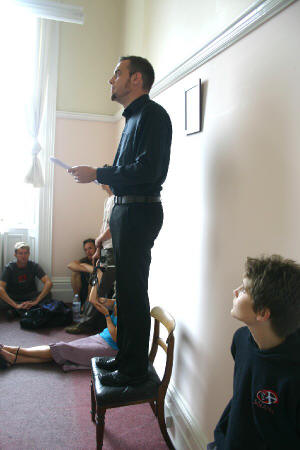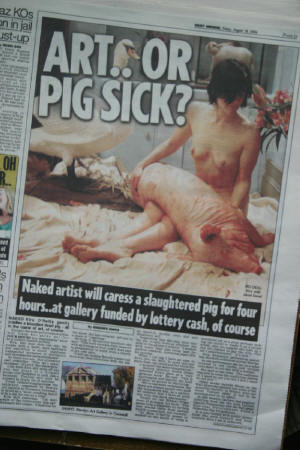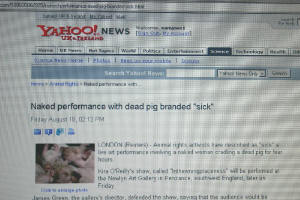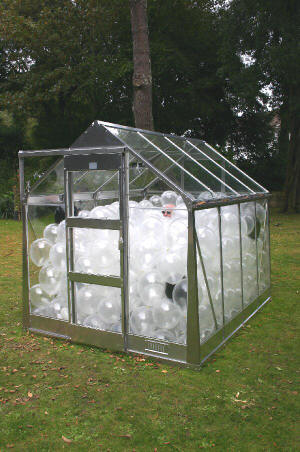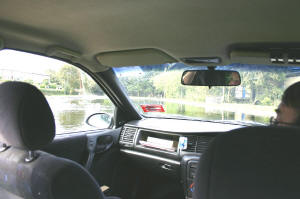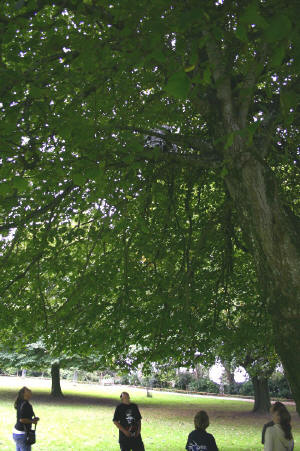| artcornwall | |||
| home | features | exhibitions | profiles | gazetteer | links | archive | forum | |||
Tract highlights x6Tract live-art was a mammoth undertaking that served, partly, as a way of keeping up an ongoing programme of events whilst the Newlyn Gallery was closed for refurbishment in the latter part of 2006. Organising one weekend of international live-art in Penzance/Newlyn would have been headache enough for most people but Andy Whall and Delpha Hudson of Artsurgery, together with Blair Todd and staff of the Newlyn Art Gallery managed three weekends in as many months. There were, when I tried to count them all, 25 different
artists or artist groups from as afar afield as Australia and the USA, who took part. As
project writer I saw most of the work – but still managed to miss four
artists, so packed was the schedule. What follows is a personal selection
of six favourites from the works that I did see. Together they demonstrate
the variety and complexity of art that was witnessed in the town during
those three months. Most of the others are archived on the Tract website. Roddy Hunter (July)A select audience were ushered into the claustrophobic atmosphere of one of the grand Victorian council rooms in St Johns to be met by Roddy Hunter, a display cabinet, a chair leaning against the wall and some video equipment. Roddy, dressed in black, began by circling the
audience, staring at them intently and creating a hushed sense of
anticipation. He then started reading from a script, all the time pacing
restlessly. With his Scottish accent, he had the demeanor of a slightly
crazed Presbyterian minister:
Roddy remarked on the obelisk that is to be seen on the seafront in Penzance, and on the place name ‘Market Jew Street’. He alluded to Salome and the beheading of John the Baptist: after whom the building is named. He did so whilst bracketing the performance with the mantras ‘I am West facing West, I am West facing East’ and ‘where is the furthest point from which to begin a journey?’ Written in a dense, fractured style not unlike Ezra Pound, the references in the script around which the performance was structured were many, and the layers thick. This complexity was deliberately compounded by the use of esoteric visual symbolism (including tape-measures laid on the floor and bars of silver) and by the troubled way Roddy used red ink to inscribe letters onto his torso. There was nothing nostalgic or sentimental about Roddy's performance. In untangling this complex web of associations, he required of his audience concentration and intelligence, patience and thought. The seriousness of Roddy's intentions was apparent from the outset and sustained attention on the part of the viewer brought its own rewards.
Kira O’Reilly (August)Over a period of four hours on the second Friday of Tract, viewers were escorted, one at a time, from the gallery shop to a back alley in the middle of Penzance. They were then led through a small door and down a corridor to an old disused social club. There it was explained, enigmatically, that they could ‘touch both animal and human flesh’ and were given latex gloves in order to do so. They were then sent in, alone, to witness the performance.
Initially Kira’s limbs were entwined with the dead pig’s, and because their skin colour was so close it wasn’t immediately obvious which were hers. She then started moving silently across the floor like a dancer leading a smaller, more passive partner, rolling slowly, occasionally heaving the heavy carcass up in order to shift it. Her hair appeared dampened by a mixture of sweat and blood, and her skin pale, and the pig itself though clean and immaculate – was marked by a massive open incision in its belly where it had been slaughtered. She looked so completely absorbed in the activity that the viewer who was only 3 or 4 feet away from her did not feel threatened. There was still an intensity to the experience of watching it that was difficult to describe, however. The performance was too strange and too cold to be erotic. It was anxiety-provoking and a bit scary, partly because there was no boundary between performer and watcher, yet it still had a macabre beauty. Kira’s performance could not have generated more of a
media storm. Although largely ignored by local papers as a story too hot
to handle, all the national papers picked up on it and ran stories on the
morning of the performance, some with full page articles. It was even
picked up by international press agencies so that it featured, somewhat
bizarrely on certain american news websites. In fact there was no sense that any of the participants were being exploited, and indeed Kira appeared to treat the pig with extreme reverence and love. Importantly too, disappointingly for the tabloids, there was nothing smutty or titillating about it. In fact Kira’s nudity had a completely different meaning that was lost in the press coverage. The most useful point of reference here is Francis Bacon, the painter, who lived in Soho and, famously painted carcasses of animals, juxtaposing them with nudes. Kira’s work traversed a similar subject area. Because Kira’s relationship with the pig was so intimate, it seemed to be a symbol or substitute for a dead human being. The piece therefore became a very strong and haunting statement about mortality, and for the duration of the performance Kira seemed to be bravely confronting and indeed embracing her own death. And several million people read about the performance in the papers, but less than twenty saw it. What does that say about contemporary mass culture?
Melissa Longenecker (August)During the week leading up to the second Tract
weekend, Melissa Longenecker explored the streets of Penzance in order to
create a detailed map of the town. Appropriately for a stranger to the
area she did this by asking residents for directions to a variety of
landmarks and locations, which were drawn as little street-maps on scraps
of paper of different shapes and sizes. Some of these drawings were
meticulous, some slap-dash: all bore the imprint and personality of the
person she spoke to and
On the Saturday afternoon she set to work assembling 100s of these fragments into a single map or collaged image of Penzance, kneeling amongst the shoppers on Causewayhead in the middle of the town. Many stopped and spontaneously offered advice and suggestions to her. And when finished the resulting object looked disarmingly beautiful. Called ‘Charter and manifest’, this was one of the few contributions to Tract that did not rely on any theatrical devices or props. Indeed there was no division between audience and performer. Instead Melissa acted as a facilitator and put the community itself centre stage. In capturing the civic pride and hospitality of the local people she made a powerful work of art that was full of humanity and optimism.
Alaistair Maclennan (September)Alaistair’s piece for Tract possessed a quiet intensity and drama and, fittingly for this grandee of British performance art, it ended up bringing the curtain down on the last weekend of Tract. Alaistair, who had performed in Newlyn around 10
years ago, started the day sitting in an empty greenhouse blowing up
balloons slowly and methodically and dropping them so that they scattered
around his feet. The greenhouse, with its futuristic silver frame, had
been especially chosen for the event, and had acquired a row of filleted
fish that peeped out from each of its gutters. For the next 8 or 9 hours the process continued without respite until slowly Alaistair disappeared under a rising tide of balloons. Although punctuated by the occasional black one, the bulk of them were a translucent, milky white colour, and so together they looked like a clump of giant frog’s spawn. It was a Saturday afternoon and the park was busy with kids playing football and Mums walking pushchairs. The fact the piece was so visible was important to its success, as were the materials which were familiar and accessible and seemed to serve to lure casual passers-by into studying the work more closely. But it was a performance that reached a number of deeper levels. The emotional pitch was slowly cranked up as the greenhouse filled, and towards the end the viewer was confronted by a subliminal awareness that, with the glass sealed up and dripping with condensation, Alaistair appeared in danger of becoming suffocated. The symbolism was deliberately ambiguous and polyvalent – but I could not help thinking that the performance was in some way a powerful demonstration of the effect of greenhouse gases on the earth’s atmosphere.
Fran Cottell (September)Billed as a series of taxi rides around Penzance, Fran Cottell’s piece did not seem, initially, a terribly enticing prospect. Having signed up for the tour, however, I was introduced to fellow punter, Chris - who turned out to be an art-historian from Cardiff - and the two of us were ushered into a ‘Nippy’ taxi cab, and whisked through the streets of Penzance to the harbour by an affable female cabbie wearing a rugby shirt.
We then had 10 minutes each with a relay of 3 other taxi drivers, who, in similar fashion took us to their favourite thing in Penzance, which amusingly in the case of the last one was his souped up black Ford Mondeo, parked in the fore-court of Penlee House. Fran’s piece was deceptive. The visual content of the work e.g. the views of Penzance was not very important, nor even was the process of the journey itself. Both were only a backdrop to the human drama which took place in the encounters between the ‘art-visitor’ and the taxi drivers. Like a form of mobile speed dating, the work was a highly choreographed quartet of facilitated social exchanges, in which the boundary between art and life, audience and performer, was dissolved. I know this because I went into the taxi thinking I was a member of the ‘audience’, but then found myself explaining the work to the taxi driver who I had originally expected to be the performer. The working through of the various role-reversals that resulted was refreshing: an intrigue that became possible only because the artist herself had managed to remain completely detached from the work while it was in progress.
Gino Saccone (September)Gino’s work was, deliberately, one of the least
visible of all the performances. He was hidden in the uppermost branches
of a majestic tree in the middle of Penlee Park, crudely wrapped in shiny
silver plastic so that he was partially visible, but not immediately
recognisable as a human form.
There were no signposts or clues as to where he was, and visitors to the park were given binoculars in order to help them in their search. I spent at least five minutes finding him. Proud of having done so, though, I was immediately joined by hordes of children and young teenagers who stood with me looking up into the cool green leaves of the tree. His presence evoked a range of responses. Gino had been there for several hours, and was so still, that none of the audience knew whether or not he was just a mannequin. Some of the children seemed to want to test this by throwing sticks at him. Others expressed genuine concern at his welfare, and one even suggested that I go and get some help. For me this evocative and uncanny piece was a kind of reworking of art from the 70s in which the artist became merged with nature: except in this case the work seemed to also refer to the 80s, and to sci-fi films in particular ‘Predator’ featuring Arnold Swarznegger. Not only were there visual parallels with ‘Predator’ but also the performance had a vaguely threatening and aggressive quality that was similar in the way it unsettled its audience.
RupertWhite October 2006
|
|||
